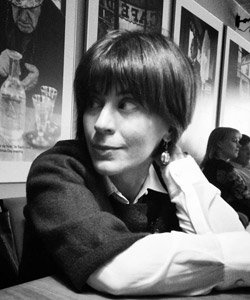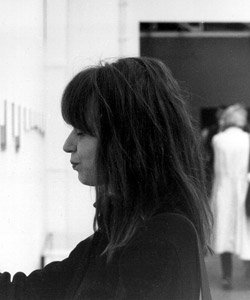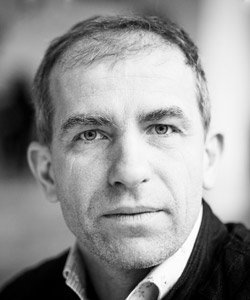27 October 2017 - Session 1
-

Jane Sharp
Cultural Translation in Transition: Episodes in Art Critical Press of the Cold War Era
The cover of the December 1967 of Opus International famously paired two supermen, one representing the USSR, the other the USA—succinctly signaling the stalemate reached during the Cold War on the cultural and on the political-ideological front. Yet in 1980, having fully absorbed the first issue of the new émigré art journal, A-Ya, the New York based artists Vitaly Komar and Alexander Melamid found it necessary to launch a succession of impassioned responses to the gap yawning between cultures—certainly including, but not limited to, the abyss that defined the boundaries of Soviet “official” versus unofficial, or underground art. Crucially, these artist-writers adopted the role of engaged critic operating within two art worlds simultaneously, to consider the damage done by each side during the Cold War era.
This paper returns to both contexts to map out the strange cleavages and diversions that shaped moments of supposed proximity in the late-1960s, when Ilya Kabakov’s Shower series, and Lev Nusberg’s Dvizhenie projects could be easily accommodated within the wider European trajectory of avant-garde art, and the early 1980s. I explore the seeming paradox that came with even more open access to the western periodical press. The consequences for artists living and working in the West joined occasional market success with near total critical marginalization. The paper will address the role of Central European journals and art critics in the 1960s, as well as that of the artists themselves in the 1980s, focusing primarily on Komar and Melamid’s two articles: “Barren Flowers of Evil,” and “In search of Religion,” both published in Artforum. -

Nataliya Mazur
“The Hamburg Score” as a Factor in the Development of Art in the USSR during the Stagnation Period
The memoirs of Anatolii Cherniaev, an official at the International section of the Central Committee of the Communist Party of the USSR, contain an account of the so-called Bulldozer Exhibition. “On a Sunday before last, 11 artists, including those who in accordance with the directions of the Ministry of Culture several times exhibited in New York and London earning ‘hard currency’ (to the benefit of the state, of course), decided to arrange a vernissage on some abandoned ground in the outskirts of Moscow. Before the event, they asked for permission from the Moscow City Council. No answer followed, so they took silence for consent. They were ruthlessly chased with the help of fire hoses and bulldozers. Their paintings were confiscated; some were crushed. Two of them were arrested and locked up for 5 days; some foreign journalists and a diplomat were roughed up. The whole affair immediately acquired international notoriety. Newspapers and radio stations made a fuss over it. Brotherly newspapers, such as Humanité, Unità a, Morning Star, and even Land og Folk denounced this response, declaring that their respective Communist Parties will have a different cultural policy if elected. A few days later, the confiscated paintings were returned to the artists with apologies. A permission to organize an exhibition in Izmailovo was granted. Apparently, Aleksandrov-Agentov [Advisor on International Affairs to the General Secretary of the Central Committee of CPSU] wrote an indignant note to Brezhnev saying more or less “for how long are we going to shit in our own pocket?” At once, it was ordered to allow the exhibition and to punish the guilty – obviously, the bulldozer drivers.”
This example indicates the significance of the Western reception in the interactions between the “field of power” and “the field of art” in the Brezhnev-era USSR, in its political, economic, and symbolic dimensions. The Western reception played an important role in the formation of internal hierarchies in official and unofficial art and in the creation of an intermediate zone of “semi-official” art. It is possible that “the Hamburg score” had also influenced a wide spectrum of responses, ranging from a deliberate intention to gain recognition in the West to an equally deliberate rejection of this factor. In my paper, I would like to discuss possible directions for the investigation of the role of Western reception in the development of Soviet art during the stagnation period. My presentation will be based on the traditions of the social history of art and illustrated with concrete cases and testimonies. -

Sabine Hänsgen
Translating Moscow Conceptualism
Since our first publication Kulturpalast: New Moscow Poetry and Performance Art (Wuppertal: Edition, S Press, 1984), I have been engaged with art, literature, and performance from the late Soviet period.
On the basis of my experience as translator, editor, video documentarist, and curator I would like to address the following topics concerning the reception of Moscow conceptualism in the German context:
- In literary translation, if we compare German and Russian culture, it is revealing to see how artists and poets reflect on their own totalitarian past by aesthetic means. I will discuss this phenomenon by analyzing my German translations of poetry by Vsevolod Nekrasov.
- Video documentation: In 1984, at a time when the Soviet state strictly controlled all media of technical reproduction, I managed to bring a high-tech video camera with me from Germany to the Soviet Union for video documentation in the Moscow Conceptualist circle. My aim was to document a unique space of aesthetic communication that seemed to me in danger of being destroyed, repressed, or forgotten. I later published this material in a video with an accompanying booklet Moskau Moskau. Video Pieces (Wuppertal: Edition S Press 1987). I wanted to raise for discussion alternative forms of communication and cooperation beyond market and mass-media circulation.
- Curatorship: In the last part of my presentation I will talk about my installation from the documentation of the group Collective Actions in the comparative exhibition Subversive Practices (Württembergischer Kunstverein Stuttgart, 2009). By opening up a “planetary” perspective through recent satellite images—upon which respective localities are marked where the Collective Actions‘ performances have taken place over the course of more than thirty years—the artistic reflection on ideology and power in late communism was extended to comprehend contemporary processes of globalization.
-

Tomáš Glanc
Dvizhenie / Movement: Singular Status and Specific Reception
My paper focuses on the international reception and public activities of Lev Nussberg and his group Dvizhenie/ (Movement) (1962-1981). This group occupied a unique place on the cultural scene of the late Soviet Union. The status of Dvizhenie was characterized on one hand by many links to the community of so-called unofficial artists and, through them, by the legacy of the then-persecuted Russian avant-garde. On the other hand, Nussberg and Dvizhenie obtained contracts for important art projects from Soviet institutions, such as Komsomol (The All-Union Leninist Young Communist League) and organizations working in the field of science, research and technologies. The group’s program focused on cosmos, cybernetics, kinetic art and new materials, which fit perfectly the requirements of Soviet authorities. Nussberg used this ambiguous situation, playing a double game. The group’s reception abroad was based on multiple factors. First, Dvizhenie was understood as a successor to the Russian avant-garde, delivering a new post-war update of abstraction, geometric art, principles of constructivism, performance, cybernetics and aesthetic provocation. Second, it represented official Soviet culture, centered around cultural activities of youth in the Soviet Union, exporting ideas about scientific research concerning cosmos, utopian visions of the future society, as well as propagating Soviet science and its achievements. And third, it was part of the unofficial art scene as well, which became especially attractive for its reception in Czechoslovakia in the late 1960s. My presentation discusses some of Nussberg's art projects, which he accomplished together with Dvizhenie. I will ask how these projects were understood by prominent Czech art theoreticians and critics, such as Jindřich Chalupecký, Dušan Konečný, Petr Spielman and others, who not only promoted the group in Czechoslovakia through writings and exhibitions, but also opened the door for the group’s reception in other Western contexts.
